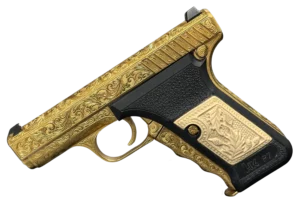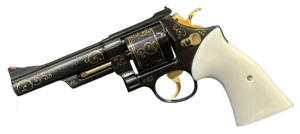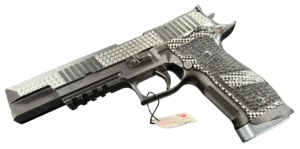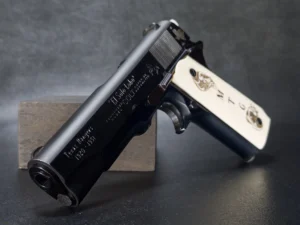Key Takeaways:
- Firearms in film aren’t just props—they’re characters in their own right: From Bond’s sleek Walther PPK to Dirty Harry’s thundering .44 Magnum, iconic movie guns shape narratives, underscore emotional beats, and reflect the personalities of the people wielding them. They add depth, context, and sometimes even steal the scene themselves.
- The real power of cinematic firearms lies in how they resonate beyond the screen: These weapons influence pop culture, fashion, and even firearm trends in the real world. Whether it’s a surge in replica sales or a spike in interest in a specific model, what happens in Hollywood doesn’t stay in Hollywood—it echoes in collector circles, gun ranges, and living rooms around the world.
- Every genre and era brings its own signature style to on-screen weaponry: Western six-shooters, sci-fi blasters, and gritty modern pistols each carry the weight of their time and place. These guns aren’t chosen at random—they’re carefully tailored to fit the story, the world, and the character, reinforcing mood, theme, and cultural context in ways words alone can’t.
There’s something unforgettable about the click of a hammer or the slow lift of a revolver on screen. Movie firearms aren’t just props—they’re symbols. They tell us who the hero is, who we should fear, and sometimes, who we should feel sorry for. Whether it’s James Bond coolly drawing his Walther PPK or Dirty Harry growling out a challenge with his .44 Magnum, these guns become more than metal and gunpowder—they become character.
But here’s the thing: it’s not about firepower. Not really. It’s about meaning. These guns are chosen with care, matched to the spirit of the film and the heart of the character. They echo the era, reflect cultural shifts, and sometimes even outshine the actors holding them.
So let’s step behind the scenes, past the camera glare and smoke-filled standoffs, to uncover the stories—and the legends—behind Hollywood’s most famous firearms.
More Than Just Bang: Why Guns Matter in Movies
Firearms in movies aren’t just there to go boom. They’re storytellers in their own right. Think about it: a battered revolver might hint at a troubled past, while a pristine sniper rifle could speak to precision and control. Guns in film are shorthand for personality.
They do a lot of heavy lifting when it comes to narrative:
- Conflict and Tension: A drawn gun can mean a standoff—or a turning point.
- Character Definition: From rebel to lawman, the gun tells us who they are before they speak.
- Setting and Atmosphere: Whether it’s a dusty frontier town or a neon-lit dystopia, the firearm sets the tone.
And let’s not forget the sound design. The soft click of a safety being disengaged can be more chilling than a shout. Hollywood understands this deeply. That’s why some guns become as iconic as the characters themselves.
The Firearms That Made Film History
Some movie guns live rent-free in our collective memory. They’re not just famous—they’re legendary. Here are a few that helped shape entire genres and carved their names into pop culture.
- Winchester Model 1873 – The Western Workhorse. Dubbed “The Gun That Won the West,” this lever-action rifle is practically a character in itself. It’s a staple in John Wayne flicks and a favorite in dusty shootouts. Rugged, reliable, and all-American.
- Colt M1911 – The Soldier’s Sidearm Used in both world wars and a regular guest star in war and detective films, the 1911 is the epitome of no-nonsense reliability. It has that old-school charm with just the right amount of grit.
- Thompson Submachine Gun – The Gangster’s Roar Also known as the Tommy Gun, this beast spits bullets and attitude. Iconic in gangster flicks, it instantly signals chaos, power, and the lawless energy of the Prohibition era.
What makes these firearms iconic isn’t just their look or history—it’s how they feel on screen. They stick with us, scene after scene, long after the end credits roll.
Spotlight on the Heavy Hitters
Some guns don’t just make an appearance—they steal the show. These are the ones we associate with characters so deeply that separating the two feels wrong.
Walther PPK – Sophistication with a Silencer
James Bond wouldn’t be Bond without his Walther PPK. Sleek, compact, and deadly, it’s the weapon of a gentleman spy. First seen in Dr. No, the PPK embodies stealth and style. It doesn’t scream danger—it whispers it.
Smith & Wesson Model 29 – The .44 Magnum of Justice
“Do I feel lucky?” Clint Eastwood’s Harry Callahan made this revolver a cinematic titan. The Model 29 isn’t just powerful—it’s imposing. Its oversized frame matches Dirty Harry’s bold, law-bending sense of justice. This gun didn’t just make noise—it made a statement.
M60 Machine Gun – Rambo’s Thunder
John Rambo and the M60 go together like fire and fury. Introduced in First Blood, this machine gun isn’t about precision. It’s about overwhelming force and sheer survival. Every time Rambo picks it up, it’s like the screen itself tenses.
Beretta 92FS – The Everyman Action Star
From Lethal Weapon to Die Hard, the Beretta 92FS became the modern action hero’s sidekick. Balanced and reliable, it bridges the gap between cool and capable. It doesn’t draw attention to itself, but somehow, it’s always there when the stakes are highest.
Auto-9 – RoboCop’s Arm of the Law
A futuristic monster of a gun, the Auto-9 looks and sounds like it belongs in a dystopian cop drama—because it does. Modified from a Beretta 93R, its design is pure sci-fi bravado. It shoots in bursts and makes RoboCop look like a walking tank. Justice, delivered in triplets.
DL-44 Blaster – Smuggler’s Charm
Han Solo’s DL-44 is more than a prop—it’s a galactic signature. Modeled on the Mauser C96, this blaster combines old-world grit with space-age swagger. Whether dodging bounty hunters or blasting stormtroopers, Han’s DL-44 is always close at hand—and always part of the action.
Guns Behind the Curtain: How the Props Are Picked
Picking a gun for a movie isn’t as simple as grabbing one off a shelf. There’s a whole team—prop masters, armorers, even directors—deciding what firearm fits a character’s story.
Is the character experienced or reckless? Refined or rough around the edges? All of that influences the choice.
But here’s where it gets interesting: most guns seen on screen aren’t firing live ammo. They’re modified to shoot blanks or customized entirely for safety and aesthetics. Some get new finishes, custom grips, or modified mechanisms for a unique on-screen look.
In other words, they’re dressed for the part, just like the actors.
Reel to Real: Pop Culture Meets the Gun World
You’ve probably seen it before. A movie hits big, and suddenly everyone wants that exact gun. Collectors start bidding. Manufacturers get flooded with orders. Even airsoft and paintball companies jump on the trend.
It’s not just hype—it’s real influence.
- Replicas become collectibles, especially if licensed or screen-used.
- Manufacturers adjust production based on demand spikes.
- Designs evolve, shaped by the aesthetics and functionality shown in films.
There’s a kind of feedback loop between Hollywood and the firearms industry. Movies glamorize a weapon; real-world consumers want it. Sometimes, it even works in reverse—real weapons show up in enough films that they gain pop culture status.
The Collector’s Obsession: Movie Guns in Real Life
For some fans, owning a replica just isn’t enough. They want the real thing—or as close to it as possible. Collectors scour auctions for screen-used props or commission custom builds to match every detail.
Why? It’s nostalgia, sure. But it’s also about history. These pieces represent something bigger than just a movie—they’re artifacts of cultural moments.
Here’s what collectors usually go for:
- Exact replicas—licensed and detailed down to the scratches.
- Modified real firearms—legally adapted to match movie specs.
- Non-functional display models—perfect for shelf appeal, minus the risk.
Whether it’s a Bond fan displaying a PPK or a Star Wars nerd showcasing a blaster, there’s something magical about holding a piece of that cinematic world.
A Gun for Every Genre, A Symbol for Every Era
Guns in movies change with the times. In the Westerns of the ’50s and ’60s, it was all about the six-shooter. Come the ‘80s, machine guns and semi-autos dominated. Then came the futuristic flair of the 2000s and beyond.
Genres shape the guns just as much as the story:
- Westerns: Colt Single Action Army, Winchester 1873
- Sci-Fi: Phaser guns, Pulse Rifles, DL-44s
- War Films: M1 Garands, Thompson SMGs, MP40s
- Noir/Detective Films: Snub-nosed revolvers, M1911s
Each decade, each setting brings its own flavor. Guns help anchor us to that time, that world, that story.
Final Shot: Why These Firearms Stick with Us
There’s a reason we remember these guns. They carry more than bullets—they carry meaning. They remind us of tension, triumph, and tragedy. Of underdogs who made it, or antiheroes who walked the line.
So, whether it’s Han Solo’s blaster or Rambo’s machine gun, these firearms aren’t just props. They’re legends.
And honestly? That’s the magic of cinema. A simple piece of metal, in the right hands, can tell a story that sticks with us for a lifetime.
Frequently Asked Questions
Because they convey a lot without saying a word. A character’s firearm can signal their background, temperament, or intentions before they even speak. Guns in film aren’t just about action—they’re about identity, mood, and storytelling weight. Whether it’s a gritty revolver or a futuristic blaster, the weapon becomes an extension of the character.
Most of the time, yes—but with a twist. Many are modified real firearms, altered to shoot blanks or outfitted with custom grips, finishes, or futuristic shells. Safety always comes first on set, so armorers work closely with directors and prop teams to make sure each weapon looks the part without putting anyone at risk.
It’s not random—it’s deliberate. Prop masters consider the character’s personality, the story’s time period, and even the visual tone of the film. A suave spy doesn’t carry the same piece as a rough-and-tumble mercenary. It’s all about visual storytelling and emotional alignment.
Absolutely. Once a firearm gains on-screen fame, demand often spikes—both for the real version and for replicas. Collectors want a piece of the magic, and sometimes manufacturers even adjust production to meet the newfound interest. Think of it as Hollywood setting off a ripple effect in the real-world firearms industry.
A few stand out immediately: James Bond’s Walther PPK, Dirty Harry’s .44 Magnum (Smith & Wesson Model 29), Han Solo’s DL-44 blaster, Rambo’s M60 machine gun, and the Beretta 92FS seen in Die Hard and Lethal Weapon. Each of these guns is tied so closely to the character, it’s hard to picture them with anything else.












2 Responses
I have learn some excellent stuff here. Definitely worth bookmarking for revisiting. I surprise how much attempt you put to create such a great informative web site.
Excellent read, I just passed this onto a colleague who was doing some research on that. And he actually bought me lunch because I found it for him smile So let me rephrase that: Thanks for lunch!